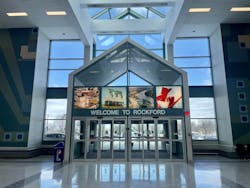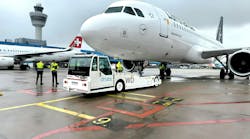The Chicago Rockford International Airport [RFD] has undergone extensive projects to improve future airport operations both on the cargo and passenger side. These operations include expanding cargo facility warehouses by 240,000 square feet and a $27 million project to add on to the existing terminal and modernize the space.
Expanding Cargo Operations
Chicago Rockford International Airport has a long history in air cargo. Starting in 1994 with UPS and then in 2016 with Amazon setting up operations. More recently, over the last four years the airport has begun to expand international cargo operations.
Part of this major expansion project included a $50 million investment by the airport authority that included three cargo warehouses totaling 240,000 square feet and parking positions for six 747 aircraft. The third and most recent facility went into lease at the end of January and will go into operation with Menzies Aviation in June 2023.
Chicago Rockford International Airport Executive Director Mike Dunn said the decision to expand cargo operations was a no-brainer.
“We really looked at the airport as an opportunity for economic development for the region. Cargo was a primary function in that economic development,” Dunn said. “… It became very clear to us that the need was with the cargo industry.”
Dunn said the most notable economic impact has been the number of jobs this project has brought to the region.
“From a community standpoint, I believe that if you talk to most people in this area and the community leaders in this region, they would all agree that the Rockford Airport is now the largest economic engine in the area in terms of hiring,” Dunn said. “We've gone from 10 years ago to maybe a couple thousand people working here on the airport campus to over 8,000 people working here on the airport campus. This has certainly brought a lot of jobs.”
Chicago Rockford International Airport Deputy Director of Operations and Planning Zack Oakley said the airport has the capacity to continue growing its international cargo market.
“We have 240,000 square feet of warehouse that is now up operating with the parking positions just outside the facility to be able to process the cargo quickly,” Oakley said. “And it just gives us that room to stay in front of, not just the cargo market in Rockford and Chicago, but really the cargo market for the entire US. I mean, air cargo, air freight, we're not just talking about Chicago as being the destination, we're really talking about the entire Midwest. Anything within roughly a 12-hour truck drive is our market.”
According to Oakley, all three of the latest cargo facility buildings were built specifically for tenants Maersk, Emery Air and Menzies.
Tailored for Cargo
Oakley said RFD must be different than large passenger hub airports because it has to be highly efficient.
“We have to be able to really focus on the needs of the cargo operator, which are completely different than the needs of a passenger operation,” Oakley said. “So it's really focusing on the speed from the time the aircraft touches ground down in Rockford, till it gets parked, to the time that freight is moving through the facility.”
Oakley said one of the biggest challenges in air freight is the processing or dwell time that freight sits in a warehouse and the time that trucks are sitting waiting to pick them up.
“One of the things that we're trying to solve, and we've been working on, is the digitization of that process to make sure that there's communication from the airline to the shipper or to the trucking company, that we don't see dwell time from the time the aircraft touches down to the time the cargo is processed and moving off the airport. We're talking hours not days,” Oakley said.
RFD is already seeing that with one of their operators on the airport.
“When they operate similar operations at a large hub, we're able to get freight out of our facility a whole day faster than what they're able to do out of the large passenger hub just because the processing time, they were able to remove that from the operation,” Oakley said. “And it just means their end customer is seeing their freight just that much faster. And that's with very limited technology, or building automation, or anything that we've been doing yet. But in the future, that's going to only improve. And cut that dwell time even further down to just from the time the aircraft lands, to the time the cargo's cleared, to the time it's leaving the airport, you're talking three to four hours versus three or four days.”
RFD signed with Cala Logistics in September 2022 to start using their system through all of the cargo facilities on the airport. Oakley said Cala is an open system and it will connect in with the existing operators' systems.
“On the back side, we're also working with some airlines to connect in with some of the systems they're operating to make sure that there's visibility throughout the entire process so the shipper can see their product at every stage of the movement,” Oakley said. “But then it ties into, when we really start getting into the buildings, that's working with the ground handlers to create efficient processes, being it through automated equipment or ball matting, or just being able to move things through the facility much more quickly than the manual processes that have existed for a number of years.”
Future development
Oakley said the airport has the capacity to continue to add additional warehousing, cargo space and aircraft parking.
“So, the three buildings that we currently have sit on about 14 acres of airport property … about 240,000 square feet of actual warehouses that's been built. In the future, we have the space for another million square feet, and about another 14 to 16 aircraft parking positions,” Oakley said. “The UPS operation, the Amazon operation, the existing warehousing that the airport has is already about 1 million square feet. So, in the future, we could see as much as roughly about 2 million square feet of on-airport air cargo warehousing and processing.”
RFD is currently in the planning phase for building a fourth cargo facility building.
“That's the building that's going to bring in more of the European design, stuff that you see in Europe and actually in Asia in terms of the large-scale processing of the technology being really utilized to move the freight through automated systems from the time it gets off the aircraft going through the facility to the time it loads the truck, being able to utilize technology throughout the process and reduce that processing time and dwell time of the facilities,” Oakley said.
Terminal upgrades
In addition to the ongoing cargo expansion project, over the last seven years the airport has also been modernizing their airport passenger terminal as well.
“It was a $27 million project to both add on to our existing terminal, but also realign and redevelop that interior space to make it more conducive to the existing passenger flows and future passenger flows,” Oakley said.
The original terminal was built in 1986 for ground boarding of 19-to-30-seat regional, turboprop aircraft servicing Minneapolis and O'Hare out of Rockford. Oakley said the current air carrier RFD has been seeing over the last 15 years is Allegiant and they’ve been operating MD-80s and Airbus 320s and 319s.
“The passenger difference between a 19-to-30-seat ground-boarding aircraft and 154-to-177-seat Airbus is completely different in how we move those passengers. So, we had to reallocate the space in the terminal,” Oakley said.
The airport’s largest gate can now handle up to 300 passengers which gives the passengers more room to spread out and allows for cleaner passenger flow.
“We were also able to automate the exit lane in terminal space. We use technology and automated exit lane versus having to have a manned exit lane,” Oakley said. “So that was one of those items that we actually added throughout this process, knowing that in the past TSA has talked about the potential of not wanting to support the officers or place the airport or the airline as a responsible entity for the exit lane. We knew that throughout the process and went with the automated exit lane, which has been very helpful.”
Additionally, airport officials can separate arriving and departing passengers more easily.
“Previously, they all came to the center of the facility. So when you have passengers checking in and going upstairs to TSA, you would also have the exiting passengers come to the same space, for a terminal that really didn't handle that flow very well,” Oakley said. “Now we're able to operate those at two separate ends of the building, be able to process those passengers and be able to move that flow much more simply.”
Looking to the future, Oakley said the new terminal design allows for more room as the airport continues to grow.
“[We] have additional room to expand and add additional either new airlines or additional flight operations and not have those same passenger congestion issues that we had previously,” Oakley said.
Leadership Changes
On March 23, the airport announced that after 12 years in his position, Executive Director Mike Dunn will retire at the end of the year. The Greater Rockford Airport Authority voted to appoint RFD Deputy Director, Zack Oakley as the new Executive Director effective Jan. 1, 2024.
"In 2006, I began working at the airport and through my various roles have taken part in growing the airport into one of the largest and fastest growing air cargo hubs in the world," Oakley said. "The efficiencies, logistics, planning, operations, technology, and hard-working men and women in the Rockford region make RFD's success possible -- and it's the honor of a lifetime to be able to fuel my passion for aerospace through my upcoming role as Executive Director. I look forward to supporting RFD's growth and leading it into its next chapter in air cargo and passenger services. I want to thank Mike Dunn for his years of service to the airport and the industry. I look forward to building off his legacy and using the experiences I've gained in my time at RFD to deliver more opportunities for the Rockford region."




